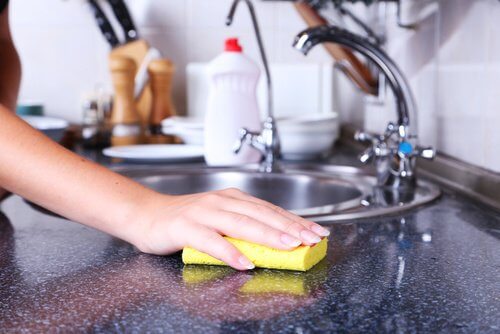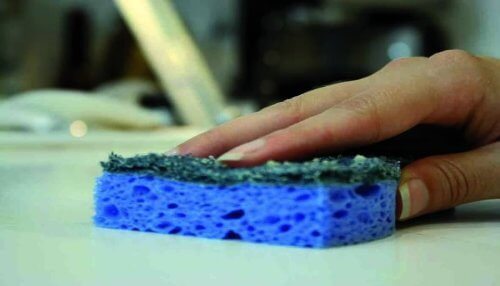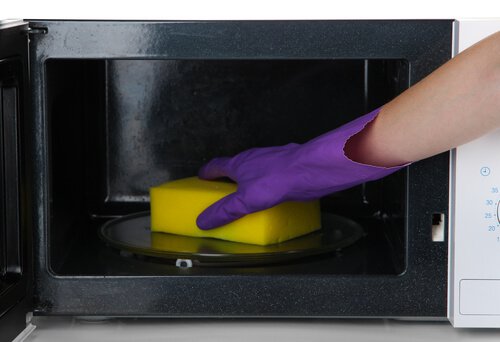The Hidden Dangers in Kitchen Sponges

Kitchen sponges are one of the most used utensils in the kitchen for cleaning dishes and surfaces.
However, this useful and ideal tool can go from being one of the best cleaning tools to one of the worst enemies to your health when not used properly.
We use sponges to remove food residue that remains on dishes after meals. However, during the cleaning process, a great deal of these food remainders are absorbed by the sponge.
When combined with the moist environment, it creates a favorable environment for the growth of bacteria, especially if the sponge stays wet from one use to the next.
Bacteria like E. coli, Staphylococcus aureus and Salmonella can survive in sponges for hours and even days after first contact. For this reason, frequently disinfecting these items apart from using regular dish soap has been advised for some time.
Visit this article: Types of Bacteria Found on Money
Kitchen sponges: the dirtiest items in your home
According to Dr. Philip Tierno, clinical professor of microbiology and pathology at the University of New York, “the dirtiest thing you have in your home is the little sponge you use to wash the dishes, more than the toilet seat or trash bin.”
This object is composed of small holes that help remove residues, but also retain dirt and microorganisms present during the cleaning process.

You might think that by using dish soap the sponge is clean and is safe to use on your dishes. However, it’s not enough as the product cannot completely eliminate all pathogens found on the inside of the sponge along with food residue.
The best way to avoid illness from a sponge full of dirty bacteria is through disinfection.
It may seem a little paradoxical that you have to clean an item that you use for cleaning, but the truth is that it’s necessary and is an effective way to eliminate bacteria.
How do I clean and disinfect sponges?

In a study conducted by the United States Agricultural Research Service (ARS) in 2007, several experiments were carried out to determine the most effective way to remove pathogens that accumulate on kitchen sponges.
The first thing they did was soak sponges at room temperature in a solution containing ground beef in order to provide the microbes needed for the study.
The following procedures were used to determine the best way to disinfect kitchen sponges:
- Soaking for 3 minutes in a solution of 10% bleach.
- Soaking in lemon juice for 1 minute.
- Placing in the microwave for 1 minute.
- Placing in the dishwasher during the drying cycle.
Also read: The Benefits and Uses of Lemon Peel
Soaking sponges in bleach or lemon juice was able to reduce the bacterial content by 37% to 87%.
Heating in the microwave was found to eliminate 99.9% of the microorganisms. The results were similar for the dishwasher method.
To disinfect in the microwave, rinse the sponge with clean water then place in the microwave on high for 2 minutes. In addition, you should also pay attention to the following tips:
- Clean the sponge after every use.
- Rotate two sponges so that you always have a clean one to use.
- Check the sponge and try to remove any food debris left after washing the dishes.
- Let the sponge dry after each use to avoid an overgrowth of bacteria.
- If the utensils or dishes are greasy from animal fats, clean them first with a paper towel before using a sponge.
All cited sources were thoroughly reviewed by our team to ensure their quality, reliability, currency, and validity. The bibliography of this article was considered reliable and of academic or scientific accuracy.
- Piédrola, G. (2002). Medicina Preventiva y salud pública. Madrid: Masson, pp. 416-423.
- Puerta-García, A., y Mateos-Rodríguez, F. (2010). “Enterobacterias”, Medicine, 10 (51): 3426-3431.
- Rutala, W. A., and Weber, D. J. (2008). Guideline for Disinfection and Sterilization in Healthcare Facilities. Atlanta (GA): CDC-HICPAC, pp. 10-13.
This text is provided for informational purposes only and does not replace consultation with a professional. If in doubt, consult your specialist.








